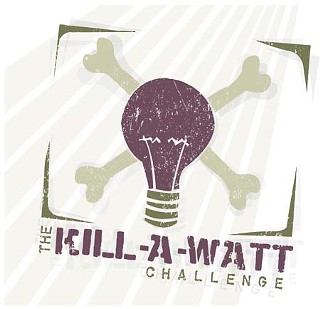A Long, Watt Summer
The citywide Kill-a-Watt Challenge kicks off
By Nora Ankrum, Fri., May 25, 2007
If you're like most Americans, you're worried about global warming, you wish you weren't part of the problem, but you're about as optimistic about your ability to go low-carbon as you are about going low-carbohydrate – or making any other of a thousand lifestyle changes that would make you a better person. Yet you can't quite afford the "easy fix" of a fancy new hybrid right now, either – right? Well, the fact is: You can still make a big difference without spending a bunch of money and without carb-starving yourself, and that's what we hope you'll find out this summer by participating in the inaugural citywide Kill-a-Watt Challenge.
Many of us tend to think of our driving habits when we think of our contribution to global warming, but in fact it's our electricity habits that account for 39% of our carbon-dioxide emissions, while transportation accounts for just 33%. James Hansen – the NASA scientist famed for introducing global warming to public discourse back in 1988 – has put forth five recommendations for addressing climate change, and two of them target electricity: 1) a moratorium on coal plants and 2) higher efficiency standards. Our "biggest use of energy," he wrote in The Nation last month, "is in buildings."
This fact presents us with an incredible opportunity, because on this issue, we need not hold our collective breath while legislators wrangle with policy. The average American generates more than 20 tons of carbon dioxide annually – more than four times the global average – and much of that is preventable. Each day we face dozens of opportunities to enact our own efficiency standards, both at home and at work, beginning with how long we run the water when we wash a dish, how many lights we forget to turn off, and how many cell phone chargers and DVD players we allow to pull electricity even when we're not using them.
We can improve those standards ourselves without much sacrifice or melodrama, and any improvement we make not only saves us money but saves utility companies from having to build yet more power plants. As Dan Reicher (the head of Google's Climate Change and Energy Initiatives) pointed out at the Sierra Club's Climate Change Forum last December, "In many respects, efficiency is our cheapest, fastest, and cleanest option. ... If I had to name one area that offers the nation huge opportunities, it's efficiency."
The Thrill of the Watt Kill
If you could put eco-friendly activities on a scale of fun to totally not, energy efficiency rates pretty well. Unlike many thankless environmental heroics, saving electricity gives you a tangible return on your investment: You can actually see that kilowatt-drop on your utility bill, right next to your monetary savings. On top of those savings, you can even earn rebates for your good behavior thanks to Austin Energy's pioneering efficiency-promoting initiatives. Still, for all your efforts, you're unlikely to be making any headlines – but we're partnering with Austin Energy this summer to change all that. The Kill-a-Watt Challenge will not only show you exactly what difference you're making, but it will give you a giant, bold-faced pat on the back and kiss on the cheek for your conscientiousness.
Energy usage in Austin increases dramatically over the summer, nearly doubling the average Austinite's electric bill, so we're challenging all you homeowners, renters, neighborhoods, and businesses out there to reduce your energy use during our most energy-intensive months: June through September. Each month, we'll be giving away a slew of prizes and also celebrating your accomplishments on our Kill-a-Watt Challenge Web site, where participants can compare their neighborhood's stats to the rest of the city, check out winners' tips, and find out how much planet-saving Austin can really accomplish.
Then, at the end of the summer, the biggest overall savers will win, among other things, a bicycle from the Peddler, wristbands to South by Southwest, 2,000 feet of radiant-barrier spray from Home Energy Savers, and an electric scooter from Alien Scooters. The businesses with the best savings can win 1,000 pounds of on-site paper shredding from Austin Shred and a $10,000 work of art from Austin Green Art. Meanwhile, we'll throw a party for the winning neighborhood, which will also be recognized for its greenness by the city of Austin.
How It Works
If you traded out an incandescent light bulb at some point this year for a compact fluorescent or perhaps replaced an old appliance with a high-efficiency version, you've probably wondered how much savings you'll really see on your utility bill this summer. We've wondered that, too, and it's the entire basis for the Kill-a-Watt Challenge. Austin Energy will compare the number of kilowatts you use each month this summer to the number you used during the same months last year, and every month we'll award prizes, and recognition, to those who show the highest proportional savings (as well as the highest overall kilowatt-drop for businesses and neighborhoods).
Since more than half the population of Austin (renters) has fewer energy-saving options than homeowners (though they have more than they probably realize, as the Kill-a-Watt Challenge will show), renters will compete only against other renters, while homeowners will compete against other homeowners. Businesses can compete as well, and if they choose, they can add their employees' home savings to their on-site figures, by joining the Water Cooler Kill-a-Watter Challenge. (They can start saving right at the water cooler, in fact; trading an old one in for an Energy Star-rated version can save 520 pounds of CO2 emissions per year.)
All you have to do to participate is sign up; all you have to do to win is follow the energy-saving tips we provide on our Kill-a-Watt Challenge Web site. We don't care which tips you try or how many. We only care how many kilowatts you save in the process.
There are a lot of energy savings not reflected in the Kill-a-Watt Challenge. For instance, everything you buy comes with a hidden cost, depending on how much energy it took to make it, package it, and transport it to the shelf where you found it. This challenge will just measure your impact from your home or business, strictly in terms of kilowatt usage shown on your monthly bill, and that's why we hope you'll visit our online Green Guide for advice on everything else you can do to mitigate your own global warming impact (including tackling that 33% of emissions from transportation).
Austin Saves the World
Contests and initiatives like the Kill-a-Watt Challenge are popping up all over the place right now – perhaps you've seen www.18seconds.org ("Change a bulb. Change everything"), which tallies the compact-fluorescent purchases of U.S. cities (Austin ranks No. 111). Or you might have noticed those new green caps on the Silk Soymilk cartons, promising the chance to win a "green home makeover." It seems everyone's realizing the same thing all at once: We don't just need to adjust our lifestyles; we need to adjust them quickly. If we're going to avoid surpassing that critical threshold – when atmospheric carbon dioxide hits 450 parts per million – we need change that's fast, far-reaching, and apparently sped along by prizes.
Such change isn't exactly unprecedented. The World War II generation was told to conserve fuel, food, and "odds & ends"; to grow "victory gardens"; to be cautious about spending to avoid inflation; and to remember that any time they were wasting their resources, they were putting their soldiers in danger, and Americans threw themselves behind the cause. The values of thrift and communal responsibility that convinced our grandmothers to can vegetables and to admire the "chipped teacup of the patriotic Mrs. Jones" are no less true today than they were then. We think that by participating in the Kill-a-Watt Challenge, you, your workplace, and your neighborhood can make a difference, just as the generations before us did. And we can't wait to see precisely how big that difference will be. ![]()









